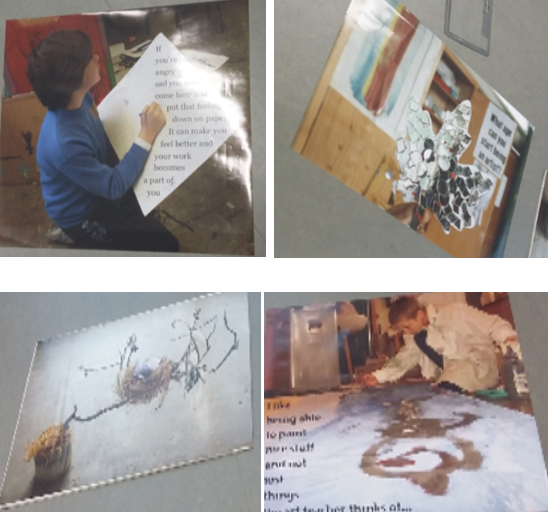The final music session presented an alternative means to engage with music education through experiencing reading sheet music in the form of figure notes. Learning and experiencing figure notes interested me greatly as I remember always having difficulty keeping up with others in music performances as sheet music is not easy for everyone to understand or read. Therefore, it can even benefit children who do not have any disabilities but just experience difficulty reading sheet music. It further allows children with disabilities that may affect their ability to comprehend sheet music or have difficulties in movement that restrict their engagement with musical instruments to have the same access to music education as all children do. This is essential to incorporate as “all children, whatever their background or aptitude, have the ability to express themselves successfully through the arts, gaining confidence and a new means of accessing other areas of the curriculum” (Bloomfield and Childs, 2000, p.3).
Moreover, being allowed time to rehearse several songs in figure notes was useful as individuals could work at their own pace, leaving teachers to regulate behaviour and help children where necessary. Performing as a whole class was also a useful experience as it “help[s] to foster teamwork skills” (Ellen, Goldstein and Stephan, 2013, p.35). “Similarly, experience of public performance in an art form may lead students to better regulate their anxiety for other kinds of non-arts public performance, such as public presentations” (Ellen, Goldstein and Stephan, 2013, p.35) which could lead to building up self-esteem.
During the art session, we were introduced to the Room 13 project whereby there is a continuous collaboration between professional artists and students in student-organised art studios (Gibb, 2012, p.237). Furthermore, discussing Room 13 posters gave insight into the benefits and thoughts of students in the project, some of which are shown below:
Room 13, as well as other alternative approaches to the arts, including figure notes, provides “an engaging, open-ended alternative to conventional ways of learning that empowers students to learn through discovery and construct knowledge themselves” (Marshall, 2014, p.7).
Essentially, Room 13 fostered “the self-knowledge, self-discipline and sheer determination needed to recognise one’s own potential and take the best out of every opportunity” (Gibb, 2012, p. 243) which would be key skills and qualities to be able to instil within children. Additionally, it would be a useful project to make children aware of or even implement as “children gain motivation and inspiration from experiencing the work of professional artists, designers, musicians, actors” (Callaway and Kear, 2000b, p.28).
Overall, visual arts, dance, drama and music should “promote individual achievement and provide the foundation for a lifelong interest and participation in the arts” (Bloomfield and Childs, 2000, p.1). Therefore, it is essential that schools “encourage a change of attitude towards the role and status of the arts in the primary school curriculum and places them in a context as the fourth ‘R’ alongside the traditional three ‘Rs’ of reading, writing and arithmetic” (Bloomfield and Childs, 2000, p.1). It is also important to integrate the arts as “they enable us to ‘say’ things to each other that cannot be expressed in any other way” (Roy, Baker and Hamilton, 2015, p.11). This is further supported by Eisner, (2002), as “the limits of our language do not define the limits of our cognition”. Similarly, the role of the teacher in the arts is to provide opportunities for children to express themselves fully through each art form. Additionally, “the arts enable us to have experience we can have from no other source and through such experience to discover the range and variety of what we are capable of feeling” (Eisner, 2002). Each session demonstrated and help me to understand the importance of teaching the arts, thus emphasising Eisner’s justifications.
Finally, the most important lesson I have taken away from experiencing these sessions are for the arts to be “learner-centred” (UNESCO, 2006, p.6 in Roy, Baker and Hamilton, 2015, p.20). Therefore, effective arts programmes should encompass “education that is relevant to the learner but also promotes universal values, education which is equitable in terms of access and outcomes and guarantees social inclusion rather than exclusion, and education which reflects and helps to fulfil individual rights” (UNESCO, 2006, p.6 in Roy, Baker and Hamilton, 2015, p.20).
References
Bloomfield, A and Childs, J (2000) Teaching Integrated Arts in the Primary School: Dance, Drama, Music and the Visual Arts [Print] Great Britain: David Fulton
Callaway, G and Kear, M (eds) (2000b) Improving Teaching and Learning in the Arts [Print] London: Falmer Press
Eisner, E (2002) The Arts and the Creation of Mind, In Chapter 4, What The Arts Teach. [Print] London: Yale University Press.
Ellen, W., Goldstein, T., and Stephan, V (2013) Educational Research and Innovation Art for Art’s Sake? The Impact of Arts [Online] Centre for Educational Research and Innovation publishing. Available: https://books.google.co.uk/books?hl=en&lr=&id=YPN_ffgNjr0C&oi=fnd&pg=PA3&dq=unesco+education+integrated+arts&ots=jk_qVk07pW&sig=Uxt1bfILABEc2Dnk7WhCVVf0v2w#v=onepage&q&f=false [Accessed: 22 December 2016].
Gibb, C (2012) Room 13: The Movement and International Network. International Journal of art and Design Education [Online] Vol. 31 (3) pp.237 – 244. Available: http://onlinelibrary.wiley.com/doi/10.1111/j.1476-8070.2012.01762.x/pdf [Accessed: 7 January 2016].
Marshall, J (2014) Transforming Education Through Art Centered Integrated Learning [Online] Available: https://static1.squarespace.com/static/54cfc63de4b08a9c05c7b299/t/55ad8587e4b099ab1ca12d0e/1437435271198/Integrated_Learning_and_Transforming_Education.pdf [Accessed: 12 December 2016].
Roy, D., Baker, W and Hamilton, A (2015) Teaching the Arts: Early Childhood and Primary Education (2nd ed) [Online] Australia: Cambridge University Press. Available: https://books.google.co.uk/books?id=ZFMQCAAAQBAJ&pg=PA145&dq=blooms+revised+taxonomy+in+the+arts&hl=en&sa=X&ved=0ahUKEwjxm6jp8u_QAhXnI8AKHZoWAzwQ6AEIIjAB#v=onepage&q&f=false [Accessed: 12 December 2016].

